Hamilcar Barca › Mesopotamia: The Rise of the Cities » Origins and History
Articles and Definitions › Contents
- Hamilcar Barca › Who Was
- Mesopotamia: The Rise of the Cities › Antique Origins
Ancient civilizations › Historical places, and their characters
Hamilcar Barca › Who Was
Definition and Origins

Hamilcar Barca (c. 285 – c. 228 BCE) was a Carthaginian general active in the First Punic War (264-241 BCE). He then quashed a rebellion closer to home between 241 and 237 BCE before returning abroad, where he successfully expanded Carthaginian interests in southern Spain. In these conflicts, Hamilcar had switched Carthage from a naval power to a land power with great success, and he firmly established the Barcid family as the ruling house of Carthage. He was the father of Hannibal Barca who continued his father's tactics and won major land battles in Italy during the Second Punic War.
NAME & FAMILY
'Hamilcar', from the Punic hml-qrt, means follower or servant of Melqart, the Phoenician/Punic god whilst 'Barca' is thought to derive from the Punic word barqa, meaning lightning, and was used in reference to Hamilcar's guerrilla tactics used in the First Punic War.
Hamilcar Barca was a member of the Barcid clan of Carthage and the father of Hannibal Barca, Rome ’s most notorious enemy, who crossed the Alps and caused havoc in Italy in the Second Punic War (218 - 201 BCE). In 237 BCE Hamilcar had famously taken his son, then nine years old, to the temple of Baal in Carthage and made him swear never to be a friend of Rome. Hamilcar's other two sons were Hasdrubal Barca and Hasdrubal Gisco, both of whom commanded during the Second Punic War.
HAMILCAR & THE BARCID LINE WOULD DOMINATE THE CARTHAGINIAN POLITICAL & MILITARY ARENAS FOR THE NEXT 35 YEARS.
FIRST PUNIC WAR
After 15 years of fighting, there was still no end in sight to the Second Punic War. Carthage had beaten a Roman army in Africa, but Rome seemed able to replace their naval fleets at will. Sicily had been the principal battleground but had yet to see a decisive victory for either side. Then the enterprising Hamilcar Barca came to the fore. He replaced Carthalo, who had not been altogether unsuccessful, as the commander of the Carthaginian fleet.
Hamilcar first raided the Italian coast at Bruttium in 247 BCE, perhaps in search of booty to pay his mercenaries, and then landed on Sicily at Heircte near Panormus (Palermo). This position allowed Hamilcar to hold a mountain base and harass the rear of the Roman forces who were besieging Drepana and Lilybaeum, which were Carthage's last remaining strongholds on Sicily. The Romans responded by blockading Hamilcar, but he seems to have been able to break out regularly and continue his guerrilla tactics. As Carthage no longer had the resources for a large army, he could not face the enemy in an all-out battle, but he did manage to capture Eryx in 244 BCE, which became his new base. This turned out to further restrict his freedom of movement, but the Carthaginian commander continued to coordinate attacks on the Italian mainland, perhaps as north as Cumae. Still, without a significant force at his disposal (fewer than 20,000 men) and despite Polybius ' praise that he was the best Carthaginian general of the war, Hamilcar's effect on the conflict was ultimately a limited one.

Roman Beach Attack
The end finally came on 10th March 241 BCE when the Romans defeated a Carthaginian fleet led by Hanno sent to relieve the besieged city of Drepana off the Aegates Islands (Isole Egadi). 50 Carthaginian ships were sunk, 70 captured and 10,000 prisoners taken. This loss was not huge, but after decades of war, it drove the cash-strapped Carthaginians to instruct Hamilcar to seek peace terms. Hamilcar then resigned his command but he would be needed again within months.
THE TRUCELESS WAR
Not only did the Carthaginians lose the First Punic War and so the control of Sicily but they were also compelled to pay huge reparations to Rome. Then the so-called Truceless War (also Mercenary War) broke out in 241 BCE. Carthage faced a joint rebellion of mercenary troops, understandably upset at not having been paid for their efforts in the first Punic War, Libyan groups seizing the opportunity of a weakened Carthage to rebel, and several cities looking for independence such as Tunis and Utica. Hamilcar Barca was recalled from Sicily and he joined Hanno the Great, who had made significant conquests in Libya while Hamilcar had been in Sicily, to quash the rebellion. First, Hamilcar broke the rebel siege of Carthage and then defeated an army led by Spendius near the Bagradas River. Hamilcar had managed to persuade the Numidian prince Naravas to defect with his cavalry force to the Carthaginian side, lured by the promise of Hamilcar's daughter for his wife. Hamilcar now had an army of 12,000 and 70 elephants with which to face the rebels.
Elsewhere, things did not go so well. Hippacra and Utica were both besieged, and Hanno was unable to free them. In 239 BCE a mercenary force took control of Sardinia and then defeated a Carthaginian army sent to re-take the island. In the same year, both Hippacra and Utica joined the rebels. The war was now becoming particularly brutal with atrocities committed on both sides. The rebels mutilated prisoners, and Hamilcar had his captives trampled on by elephants. Long-time rivals Hamilcar and Hanno could not agree on the best strategy and eventually the army was permitted to choose which general should lead them. They chose Hamilcar.
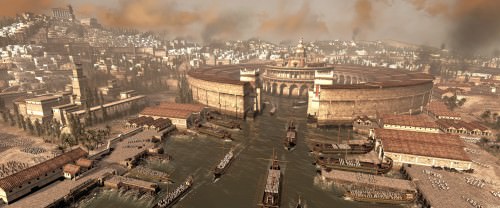
Carthage and its Harbour
The war started to improve for Carthage when they were aided by Rome, who repatriated captured Carthaginian soldiers for free, and the tyrant of Syracuse Hiero, who feared that without Carthage then Rome might act at will in the central Mediterranean. Hamilcar broke off the second siege of Carthage by Mathos and headed inland where a rebel army awaited him. There, after several skirmishes, Hamilcar cornered the enemy at 'the Saw' (Prion), a ridge in the Libyan mountains. The rebel army was starved of supplies and eventually sought to surrender. Hamilcar refused and slaughtered all of them except for the commanders. These were taken to Tunis, the rebel capital, and crucified in full sight of Mathos' army. Meanwhile, Mathos had defeated a Carthaginian army, and he dealt the same treatment to the captured Carthaginian general. Mathos could not, though, resist a joint army of Hamilcar and Hanno, and he was driven out of the city and defeated at Byzacium.Finally, with the fall of the rebel capital in 237 BCE, Hippacra and Utica back on the Carthaginian side, and Libya now compliant, Carthage had regained control of its African empire. Hamilcar and the Barcid line would now dominate the Carthaginian political and military arenas for the next 35 years.
HAMILCAR IN SPAIN
Carthage was on the rise again and eager to create a wider Mediterranean empire. Without a significant fleet and having lost their strategically important fortresses in Sicily, Corsica and Sardinia, the Carthaginians, though, had to look elsewhere for a source of money to fund their armies. The answer was Spain. They had long since had control of the old Phoenician colonies there, and it had already proven a rich source of silver. Accordingly, Hamilcar Barca was dispatched in 237 BCE to expand Carthaginian territory, which he did, establishing his base at Gades ( Cadiz ) and founding a new city of Acra Leuce. He supplemented his original force of some 25,000 with local recruits and amassed a 50,000-strong army which included a corps of Numidian cavalry (supplied by Prince Naravas) and 100 elephants. Using a blend of terror and diplomacy Hamilcar relentlessly expanded his control over southern Spain. The riches from these campaigns were channelled back to Carthage.Hamilcar's move away from the traditional naval power of Carthage to a land force was reaping fantastic rewards.
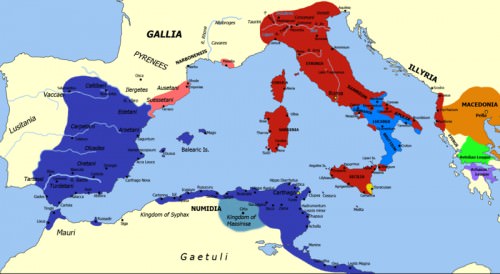
Territories During the Second Punic War
By the time Hamilcar had conquered southern and south-east Spain, Rome became suspicious of their old enemy's intentions.Envoys were sent to Hamilcar demanding an explanation. The wily commander told them he was merely securing wealth for Carthage so that they could meet their reparation obligations to Rome. Certainly, tribute in money, if not men, was extracted from local cities and new silver mines were worked. The Carthaginian's, in any case, continued campaigning in Spain. After the siege of Helice and betrayed by local allies, Hamilcar retreated and drowned while crossing a river in the winter of 229/228 BCE. Hasdrubal the Fair then took over command of the Carthaginian army. When he was replaced by Hannibal in 221 BCE, the Carthaginians broke the territorial agreement with Rome of 226 BCE not to cross the River Ebro and attacked Rome's ally Saguntum (Sagunto). This led to the Second Punic War and Hannibal taking the army across the Alps into Italy. Hamilcar had indeed got his wish that the Barcid line would be no friend of Rome.
Mesopotamia: The Rise of the Cities › Antique Origins
Ancient Civilizations
Once upon a time, in the land known as Sumer, the people built a temple to their god who had conquered the forces of chaos and brought order to the world. They built this temple at a place called Eridu, which was “one of the most southerly sites, at the very edge of the alluvial river plain and close to the marshes: the transitional zone between sea and land, with its shifting watercourses, islands and deep reed thickets” (Leick, 2).
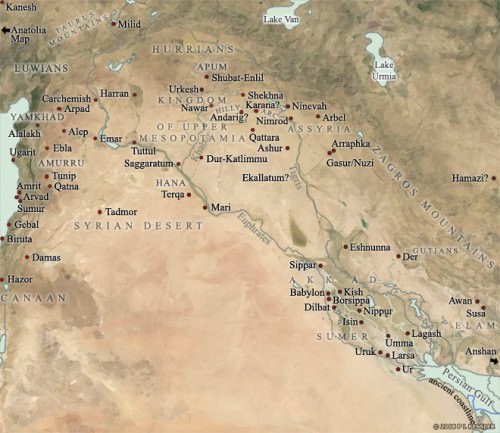
Map of Mesopotamia, 2000-1600 BC
MYTHOLOGICAL ORIGINS
This marshy area, hemmed about by hard land and sand dunes, represented to the people the life-giving force of the god and provided a physical manifestation of the order their god had created from chaos; the sweet waters of life were celebrated at Eridu as they were associated with what the Sumerians called the abzu, the primordial source of all existence, the realm in which the gods lived and from which they emerged.
The god Enki came forth from the abzu and dwelt at Eridu, and The Sumerian King-list states, “After kingship had descended from heaven, kingship was in Eridu.” This cultural centre became the first city to the Sumerians. The historian Gwendolyn Leick writes:
Thus the Mesopotamian Eden is not a garden but a city, formed from a piece of dry land surrounded by the waters. The first building is a temple…This is how Mesopotamian tradition presented the evolution and function of cities, and Eridu provides the mythical paradigm. Contrary to the biblical Eden, from which man was banished forever after the Fall, Eridu remained a real place, imbued with sacredness but always accessible (2).
Eridu was not only the first city in the world to the Sumerians, but the beginning of civilization. Every other city ever raised, they believed, had its origin in the sand and waters which surrounded Eridu.
MODERN THEORIES
Modern scholars disagree on why the first cities in the world rose in the region of Mesopotamia instead of elsewhere.Theories range from the ancient alien hypothesis to social or natural upheavals that forced people to band together in urban centers, to environmental concerns and even to forced migration of rural communities to cities. None of these theories are universally accepted while the ancient alien hypothesis is rejected by every reputable scholar. What is agreed upon, however, is that the moment the ancient Sumerians of Mesopotamia decided to engage in the process of urbanization, they changed the way humans would live forever. The historian Kriwaczek writes:
This was a revolutionary moment in human history. The [Sumerians] were consciously aiming at nothing less than changing the world. They were the very first to adopt the principle that has driven progress and advancement throughout history, and still motivates most of us in the modern times: the conviction that it is humanity's right, its mission and its destiny, to transform and improve on nature and become her master (20).
THE SITE OF ERIDU PROVIDES LITTLE TO SUGGEST IT WAS EVER ANY MORE THAN A SACRED CENTRE, PERHAPS EVEN DEFINED AS A LARGE VILLAGE OR TOWN BY MODERN-DAY STANDARDS OF SCHOLARSHIP.
This principle Kriwaczek refers to is perhaps no more than the natural inclination of human beings to gather together for safety from the elements, or it could have its roots in religion and communal religious practices which, among the benefits they offer, provide an assurance that there is order and meaning behind the seemingly random events of life. The historian Lewis Mumford claims that “the habit of resorting to caves for the collective performance of magical ceremonies seems to date back to an earlier period, and whole communities, living in caves and hollowed-out walls of rock, have survived in widely scattered areas down to the present. The outline of the city as both an outward form and an inward pattern of life might be found in such ancient assemblages” (1). Whatever it was that first gave rise to the development of the cities in Mesopotamia, the world would never be the same. Kriwaczek writes:
From before 4,000 BCE, over the next ten to fifteen centuries, the people of Eridu and their neighbors laid the foundations for almost everything that we know as civilization. It has been called the Urban Revolution, though the invention of cities was actually the least of it. With the city came the centralized state, the hierarchy of social classes, the division of labour, organized religion, monumental building, civil engineering, writing, literature, sculpture, art, music, education, mathematics and law, not to mention a vast array of new inventions and discoveries, from items as basic as wheeled vehicles and sailing boats to the potter's kiln, metallurgy and the creation of synthetic materials. And on top of all that was the huge collection of notions and ideas so fundamental to our way of looking at the world, like the concept of numbers, or weight, quite independent of actual items counted or weighed – the number ten, or one kilo – that we have long forgotten that they had to be discovered or invented. Southern Mesopotamia was the place where all that was first achieved (20-21).
THE RISE OF URUK
The concept of the city, first manifested in the construction of Eridu, did not remain bound by that area for long. Urbanization spread across the region of Sumer rapidly beginning in c. 4500 BCE with the rise of the city of Uruk, today considered the world's first city. It may well be that Eridu is in fact the world's first city, as the Sumerian myths maintain, but Eridu was founded c. 5400 BCE, long before the advent of writing (c. 3000 BCE), and, by that time, Uruk was long established and had created and discarded numerous artifacts which, in the present day, attest to its size and population and so substantiate the claim that Uruk is the world's first city. The site of Eridu, on the other hand, provides little to suggest it was ever any more than a sacred centre, perhaps even defined as a large village or town by modern-day standards of scholarship.
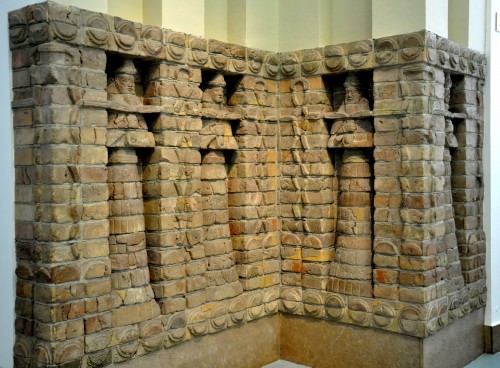
Facade of Inanna's Temple at Uruk
URUK & ERIDU IN MYTHOLOGY
Sumerian mythology supports the contention that Uruk superseded Eridu in the poem Inanna and the God of Wisdom. In this work, the goddess Inanna, whose home is in Uruk, goes to Eridu to visit her father Enki. Kriwaczek notes,
Mesopotamians recognized Enki as the god who brings civilization to humankind. It is he who gives rulers their intelligence and knowledge; he `opens the doors of understanding'…he is not the ruler of the universe but the gods' wise counsellor and elder brother…Most importantly, Enki was the custodian of the meh, which the great Assyriologist Samuel Noah Kramer explained as the `fundamental, unalterable, comprehensive assortment of powers and duties, norms and standards, rules and regulations, relating to civilized life' (30).
At the beginning of the poem, Inanna says “I shall direct my steps to Enki, to the Apsu, to Eridu, and I myself shall speak coaxingly to him, in the Apsu, in Eridu. I shall utter a plea to Lord Enki” indicating clearly that she wants something from her father. Enki seems to be aware of her coming and instructs his servant to make her welcome, to “pour beer for her, in front of the Lion gate, make her feel as if she is in her girl-friend's house, make her welcome as a colleague.” Inanna sits down to drink beer with her father and, as they become progressively more drunk together, Enki offers his daughter one meh after another until she has over a hundred. Enki then seems to pass out from the drinking and Inanna, with the meh, hurries from Eridu back toward Uruk. When Enki wakes and finds he has lost his meh, he sends his servant Isimud to get them back. The rest of the poem relates Isimud's futile attempts to keep Inanna from reaching Uruk with the meh. She succeeds in bringing “the Boat of Heaven to the Gate of Joy” at Uruk, and “Where the boat came to dock at the quay, she named that place with the name White Quay” to commemorate her triumph. The poem has been interpreted to render, in symbolic form, the transfer of power and prestige from the city of Eridu to Uruk.
ARCHAEOLOGICAL EVIDENCE
This version of events, of course, comes from Sumerian mythology but there has existed, since serious excavations began in the mid-19th century CE, ample evidence to suggest that there is some historical truth behind the poem. Eridu did seem to decline as Uruk rose in prestige, even though the older city always remained a sacred centre and place of pilgrimage.
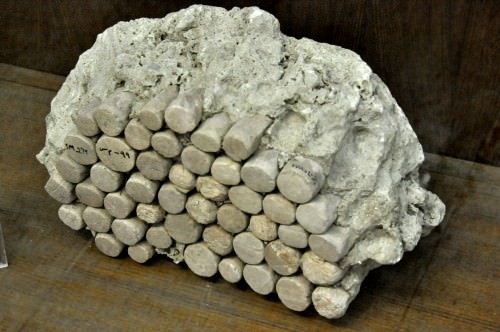
Mosaic Fragment from Uruk
As further archaeological excavations have proceeded in the Near East, however, scholars have come to question whether the traditional view of urbanization beginning in Sumer and spreading north can still be considered valid. The discovery of the settlement of Tell Brak (in modern day Syria ), founded c. 6000 BCE, seems to some scholars to suggest that the Urban Revolution may have begun in the north and that the claim that it originated in Sumer has only been accepted because the Sumerians invented writing and so their version of history is accepted as truth and, of course, because the earliest excavations of the 19th century CE were in Sumer.
While the settlement at Tell Brak is older than Eridu, the question of where cities first rose is best addressed by defining what is meant by a `city' in ancient times. Professor ME Smith of Arizona State University writes:
The earliest large urban settlement was Tell Brak in the dry farming zone of northern Mesopotamia. During the Uruk period (3800-3100 BCE) this city consisted of a central zone of public architecture surrounded by sprawling suburban settlement over 1 square kilometer in extent. At the end of this period, the site declined and the focus of urban development shifted to southern Mesopotamia (The Sage Encyclopedia of Urban Studies, 24).
The problem with this assertion, however, is that it fails to address the definition of `city'. Was Tell Brak a `city' or a large town or village? Professor George Modelski of the University of Washington maintains that it was not a city and bases his claim on the 1987 CE work of the historian Tertius Chandler, Four Thousand Years of Urban Growth. Chandler claims that an ancient city should be defined by the size of its population. Modelski writes, “One important estimate concerns Uruk, that on the basis of the work of Robert Adams (1967, 1981), as the largest city of the very early period” (3). Tell Brak, according to his definition of a city, would be regarded as more of a settlement since the population does not seem to have been great enough to qualify it as an urban centre. This, of course, is a modern method of determining what is and is not a `city' and there is no way of knowing how the ancient Mesopotamians would have defined the entity of the city or how they regarded a settlement such as Tell Brak.

Foundation Figurine of Ur-Nammu
SUMERIAN ORIGIN
What is certain, however, is that, for whatever reason, the Urban Revolution began in Mesopotamia and, it seems certain, in the region of Sumer. The earliest cities mentioned are Eridu, Bad-tibira, Larak, Sippar, and Shuruppak all of which are located in Sumer. Regarding the various theories as to why Sumer and not elsewhere, Kriwaczek writes that some scholars
see the emergence of civilization as an inevitable consequence of evolutionary changes in human mentality since the end of the last ice age …But we humans aren't really like that; we don't react so unthinkingly. The actual story would have to allow for the everlasting conflict between progressives and conservatives, between the forward and backward looking, between those who propose `let's do something new' and those who think `the old ways are best', those who say, `let's improve this' and those who think `if it ain't broke, don't fix it'. No great shift in culture ever took place without such a contest (21).
Once upon a time, in the land known as Sumer, the people built a temple to their god who had conquered the forces of chaos and brought order to the world. Those people then continued the work of their god and established order throughout the land in the form of the city. The answer to the question of why it happened in Mesopotamia instead of elsewhere can best be found in considering the culture of that particular society. The people of Mesopotamia, regardless of the region or ethnicity, shared the common concern with establishing and maintaining order and, because of their religious beliefs, a near-obsession with control of the natural world. It should not be surprising, then, that such a culture would have been the first to conceive of and construct the urban entity which most completely separates human beings from their natural environment: the city.
LICENSE:
Article based on information obtained from these sources:with permission from the Website Ancient History Encyclopedia
Content is available under License Creative Commons: Attribution-NonCommercial-ShareAlike 3.0 Unported. CC-BY-NC-SA License